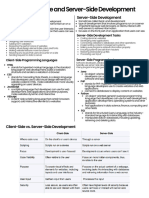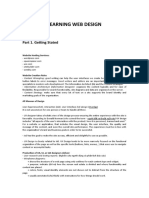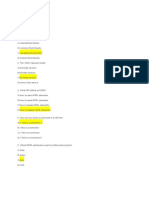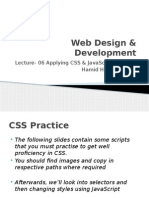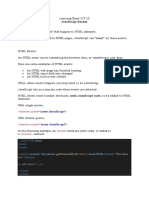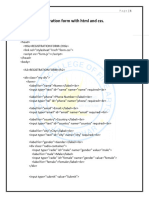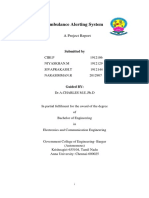Web Design Specialist (Adobe CS5 Web Edition)
The Web Design Specialist course (formerly titled Design Methodology and Technology) teaches you how to design and publish Web sites. General topics include Web Site Development Essentials (such as the site development process, customer expectations, and ethical and legal issues in Web development), Web Design Elements (such as aesthetics, the site user's experience, navigation, usability and accessibility), Basic Web Technologies (such as basic Hypertext Markup Language [HTML], Extensible HTML [XHTML] and extended technologies, image files, GUI site development applications, site publishing and maintenance) and Advanced Web Technologies (such as multimedia and plug-in technologies, client-side and server-side technologies, and Web databases). In this course, you will work with popular production tools such as Microsoft Expression Web, and Adobe Dreamweaver and Flash. You will study design and development technologies such as Cascading Style Sheets (CSS), Extensible Markup Language (XML), JavaScript, Java applets, Dynamic HTML, plug-ins, multimedia and databases. You will also explore the extensibility of design tools, incompatibility issues surrounding these tools, and the functionality of current Web browsers. Web Design Specialist will also teach you to manage the Web site development process. You will learn about new technologies and traditional strategies involving the Web designer job role. Throughout this course, you will learn how Web sites are developed as managed projects, relate Web site development to business goals, and apply guidelines for user accessibility to Web site development. You will also consider site design from several perspectives. You will approach design from the Web user's perspective so that you can identify with user interests and needs. You will also assume the roles of Web designer and project manager, as you work through the Web site development process by evolving a Web presence site into a working prototype Web project. Hands-on labs include real-world scenarios based on a previously live version of the Habitat for Humanity International Web site. Note that students will build prototype pages using Habitat for Humanity content. This content is provided by Habitat for Humanity with permission to use it in labs teaching site development skills. The prototype pages that students build do not necessarily represent, duplicate or simulate the current live Habitat for Humanity Web site, which can be visited at www.habitat.org.
Topics
Overview of Web Design Concepts
Web Technology The Nature of the Web Web Design Concepts New Technologies Evaluating Your XHTML Skills The Metaphor Mystery Meat Navigation The Mindmapping Process Creating a Web Site Wireframe Creating a Web Page Wireframe
Navigation Concepts
Web Page Layout and Elements
Web Users and Site Design Effective Web Page Layout Branding and the Web Color and Web Design Fonts and Web Design
Web Development Teams
Web Teams and Tasks Web Project Management Web Project Collaboration Your Web Design Portfolio Your Web Design Business
Why Is Navigation Critical? Primary and Secondary Navigation Navigation Hierarchy Site Structure, URLs and File Names Familiar Navigation Conventions Guided Navigation Navigation Action Plan
Web Graphics
Web Site Usability and Accessibility
Web Project Management Fundamentals
Web Project Management Phases Project Documentation and Communication
Audience Usability and Accessibility Defining Usability Web Site Usability Testing Web Page Accessibility
Web Site Images Digital Imaging Concepts Raster vs. Vector Graphics Graphics Applications Image File Formats Creating and Optimizing Images Essential Graphic Design Concepts
Browsers
Multimedia and the Web
Web Site Development Process
Bottom-Up Approach to Web Development Understanding the Business Process Defining a Web Site Vision From Vision to Strategy Web Site Specifications
Browsers and Navigation Browsers and Design Considerations Browser Adoption Major, Minor and Alternative Browsers Creating Aliases with TinyURL Utilizing CAPTCHA
Multimedia and Web Sites Current Multimedia Capabilities Animation and the Web Audio and the Web Video and the Web Goals of a Multimedia Site Multimedia Site Design Basics User Interaction Selecting Multimedia Elements
Certification Partners, LLC - 1.800.228.1027 - 1.602.275.7700 www.ComputerPREP.com - www.CIWcertified.com - www.Certification-Partners.com
Ethical and Legal Issues in Web Development
Ethics and Law in Web Development Ethical Issues and the Web Legal Issues and the Web
Site Development with Microsoft Expression Web 3 Introduction
The Transition from FrontPage Microsoft Expression Web 3 Expression Web Views Expression Web Menus and Toolbars Opening Web Sites and Files in Expression Web Developing W3C-Compliant Code with Expression Web
Dreamweaver Assets and Library Editing X/HTML in Dreamweaver Jump Menus in Dreamweaver Site Search Forms in Dreamweaver Adobe Exchange
HTML and the Evolution of Markup
Creating Web Pages Using Open-Source Tools
Function of Markup Languages SGML: A Short History What Is HTML? HTML Goals The HTML Standard HTML 1.0 and 2.0 HTML 3.0 and 3.2 HTML 4.0 and 4.01 Separating Format from Structure in HTML Extensible HTML (XHTML) Reference Sites for Web Developers
Site Development with Expression Web 3 Basic Features
Open-Source GUI Editors GUI HTML Editors vs. Text Editors Open-Source Text Editors Creating a Static Web Page Using Templates Checking Spelling
XML and XHTML
What Is XML? XML Goals What Is an XML Document? Rules for Well-Formed XML HTML Transition to XML What Is XHTML? Applying a Single Standard Consistently
Web Page Structure Tables and Framesets
Creating Structure with X/HTML Tables Diagramming a Basic X/HTML Table Borderless Web Page Structure X/HTML Frames and Framesets The X/HTML <frameset> Tag The X/HTML <frame> Tag Targeting Hyperlinks in X/HTML The X/HTML <noframes> Tag
Page Layout Options in Expression Web Creating a New Web Site Using Expression Web Page Layout with CSS Inserting Images with Expression Web Creating Hyperlinks with Expression Web Creating Image Maps with Expression Web Creating Navigation Bars Using CSS Expression Web's Dynamic Web Templates Pasting Formatted Text with Expression Web Pasting X/HTML content with Expression Web
Image Editing with Adobe Fireworks CS5
Adobe Fireworks CS5 Creating an Image Document in Fireworks Adding Text to Images in Fireworks Cropping Images in Fireworks Image Layers in Fireworks Image States in Fireworks Transparent Images in Fireworks Image Slices in Fireworks
Multimedia with Adobe Flash Professional CS5
The History of Flash Flash Technology Features Developing with Flash Flash Shapes Color and Fills in Flash
Site Development with Expression Web 3 Advanced Features
Cascading Style Sheets
Style Sheets Cascading Style Sheets Defining and Using Styles Changeable Style Attributes Style Guides Changes from CSS1 to CSS2 Page Layout with CSS The CSS Box Model Document Flow and Positioning CSS Positioning Schemes
Expression Web Styles Adding Interactivity to Web Pages Creating Web Forms with Expression Web Connecting to Databases Expression Web Reports Options for Replacing Old Webbots
Multimedia with Flash Professional CS5 Timeline, Layers, Symbols and Buttons Flash Timeline Flash Layers Saving and Publishing Flash Movies Flash Symbols Flash Buttons Customizing the Flash Library
Multimedia with Flash Professional CS5 Tweens
Flash Tweens Motion Tweens in Flash Shape Tweens in Flash Tweening Text in Flash
Site Development with Adobe Dreamweaver CS5 Introduction
Adobe Dreamweaver CS5 Dreamweaver Layout Options
Site Content and Metadata
Site Development with Dreamweaver CS5 Basic Features
Multimedia with Flash Professional CS5 Movie Clips
Written Web Site Content Internet Marketing and Search Engine Optimization (SEO) Metadata The <meta> Tag and Document Identification The <meta> Tag and Search Engines The <meta> Tag and Delayed File Change
Page Layout in Dreamweaver Creating Image Maps in Dreamweaver Creating Templates in Dreamweaver Importing Content in Dreamweaver
Flash Movie Clips Adding Sound to Flash Files Adding Flash Movies to X/HTML Files Testing for the Flash Player Plug-In
Site Development with Dreamweaver CS5 Advanced Features
Multimedia with Flash Professional CS5 ActionScript, Masks and Practical Uses
Rollover Images in Dreamweaver Dreamweaver Web Forms Dreamweaver Behaviors
Flash ActionScript Mask Layers in Flash Using SWF and SVG Files on the Web Flash and Accessibility
Certification Partners, LLC - 1.800.228.1027 - 1.602.275.7700 www.ComputerPREP.com - www.CIWcertified.com - www.Certification-Partners.com
JavaScript and DHTML Fundamentals
Why Script? JavaScript and Common Programming Concepts What Is JavaScript? JavaScript vs. Other Languages Embedding JavaScript into X/HTML Using JavaScript to Communicate with the User JavaScript Functions Using JavaScript for Browser Detection Dynamic HTML (DHTML)
Rich Media Content Creating a Downloadable File Introduction to Java Java Applets Applets and Animation Applet Authoring Tools and Resources
HTTP Servers and Web Applications
Database Anatomy Database Queries Database Management System (DBMS) Connecting Web Pages to Databases Database Tools, Products and Programs
Plug-Ins and Java Applets
Plug-In Technology Plug-In Installation Adobe Shockwave and Flash Players Adobe Reader RealNetworks RealPlayer
What Is an HTTP Server? Accessing Servers and Services Basic HTTP Server Administration Server-Side Technologies Web Servers and Cookies Enabling, Disabling and Deleting Cookies Setting Cookie Files XML and Web Applications Syndicated Feeds
Web Site Publishing and Maintenance
Databases
Web Site Testing Web Site Publishing Web Site Hosting Web Publishing with an FTP Client Web Publishing with Expression Web Web Publishing with Dreamweaver Comparing Web Publishing Tools Maintaining Web Sites Web Server and Web Site Security
Web Design and Databases
Target Audience
Web authors, marketing and communications professionals, PR professionals, Webmasters, graphic designers, desktop designers, technical writers, and library scientists.
Job Responsibilities
Implement and maintain hypertext -based Web sites using authoring and scripting languages; create Web content; use Web management tools and digital media tools; and apply human-factor principles to design.
Prerequisites
Students taking this course need a basic understanding of Internet functionality and tools, and X/HTML. No prerequisite courses or certifications are required prior to taking this course or the corresponding certification exam. However, the course and exam are challenging and comprehensive. CIW offers the Web Foundations Associate curriculum to provide the base of foundational X/HTML and Internet knowledge necessary for this course. The CIW Foundations courses are not required, but for many candidates they are extremely helpful.
Certification Partners, LLC - 1.800.228.1027 - 1.602.275.7700 www.ComputerPREP.com - www.CIWcertified.com - www.Certification-Partners.com




























